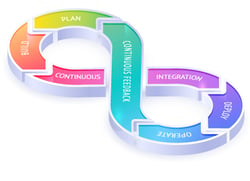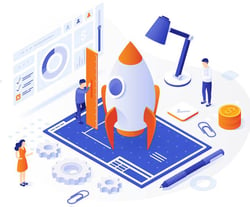 With the increasing number of products introducing software components and the constant appetite for new customer features, many companies are looking to adopt Lean-Agile approaches for product development to stay competitive. Many resources out there help lead companies towards Lean-Agile approaches, such as the SAFe Framework, which helps companies of all sizes make Lean-Agile methods work for them, no matter the scale of production. But adopting any new method also requires a shift in mindset. Here are five mindset shifts to help product managers confidently make the switch.
With the increasing number of products introducing software components and the constant appetite for new customer features, many companies are looking to adopt Lean-Agile approaches for product development to stay competitive. Many resources out there help lead companies towards Lean-Agile approaches, such as the SAFe Framework, which helps companies of all sizes make Lean-Agile methods work for them, no matter the scale of production. But adopting any new method also requires a shift in mindset. Here are five mindset shifts to help product managers confidently make the switch.
1. Shifting the Focus from Prototype to MVP
 In traditional stage-gate approaches, the goal is to develop a complete prototype to test with and gather feedback on to make adjustments before launching. Building a full prototype offers detailed insight into the final product for stakeholders and potential customers. However, this method of prototyping requires significant time and resources to develop, which is why Lean-Agile methods focus instead on a minimum viable product or MVP.
In traditional stage-gate approaches, the goal is to develop a complete prototype to test with and gather feedback on to make adjustments before launching. Building a full prototype offers detailed insight into the final product for stakeholders and potential customers. However, this method of prototyping requires significant time and resources to develop, which is why Lean-Agile methods focus instead on a minimum viable product or MVP.
Simpler Methods of Prototyping
Early prototypes designed to give the audience an idea of how a product works before building the actual product are often helpful when developing ideas. In agile, since the idea is iteration and learning, the objective is to reduce the cost of failure so you can reproduce prototypes until you find the right solution for the market. These can be as basic as hand-drawn sketches or post-its for software components or as sophisticated as a computer-simulated design for complex products and physical prototypes that have been built using rapid prototyping techniques. This allows for iterative development in shorter iterations and reduction of cost of failure.
Prototypes vs. MVP
An Agile approach to developing complex products shifts from building a fully completed prototype over several years to building the Minimum Viable Product (MVP). An MVP empowers a product manager to validate their ideas and gather user feedback in a much shorter timeframe as opposed to over-engineering a product for the market. It is just enough features to make the product attractive for the intended market and customer base.
This iterative process makes it easier to change the MVP and increases the probability of releasing a successful product that is just what the market needs at the time with reduced complexity and increased value. Creating MVPs is essential in today's business environment, as market changes and technological advancements require a business to pivot quickly and adapt to meet customer needs.
The Need For Ongoing Product Development
A good philosophy to have in product development is the belief that the product process doesn't end with the release date. Instead, you and your teams are constantly researching the market, revising the product, and introducing new features to improve functionality and ensure relevance in the market. The only way to stay competitive in your market is to innovate, improve your existing products, or introduce new models to your product lineup.
2. Temporary Project Teams to Continuous Product Teams
 Instead of assembling development teams for a temporary project and dismantling them when done, as in the stage-gate approach, a more efficient option is to have a continuous team overseeing product development across the product lifecycle.
Instead of assembling development teams for a temporary project and dismantling them when done, as in the stage-gate approach, a more efficient option is to have a continuous team overseeing product development across the product lifecycle.
A continuous team stays with the product from conception through to the launch and is involved in further development of the product over time. The same team can create subsequent generations of the product while constantly improving it over many years. This allows the product team to understand their product thoroughly and maintain a working knowledge of the process.
Continuous Agile teams are preferable to temporary project teams for a variety of reasons, such as:
- They are closely aligned to the product vision.
- They have learned to work together for a smoother workflow.
- There is less organizational disruption compared to setting up new teams.
- They offer improved collaboration with other organizational stakeholders.
- Each team member forms strong relationships and develops a strong sense of identity within the company.
- They have a greater commitment and sense of responsibility for the success of the product.
3. From Top-down Annual Planning to Value Stream and Participatory Budgeting
 Traditionally, organizations follow a top-down approach to annual planning and budgeting. Senior executives approve the budget based on their strategic vision; this process involves extensive planning, which can be time-consuming and is generally an inflexible process. Once a product plan is approved, budgets are locked in, with a clear focus on engaging in that plan to completion.
Traditionally, organizations follow a top-down approach to annual planning and budgeting. Senior executives approve the budget based on their strategic vision; this process involves extensive planning, which can be time-consuming and is generally an inflexible process. Once a product plan is approved, budgets are locked in, with a clear focus on engaging in that plan to completion.
Value Stream Budgets
The shift to value stream budgets ensures that budgets are allocated to value streams—a series of actions or activities that deliver value to the consumer—instead of projects or departments. By aligning budgets with value streams, organizations can ensure important resources are funneled toward activities that directly contribute to value delivery.
Participatory Budgets
Another component of Agile methodology is the idea that budgeting should be a collaborative and participatory process. In this situation, the teams and individuals who are most familiar with the work and have the best understanding of what will generate value actively participate in the budgeting process.
This approach ensures that budgets are based on the insights of those who will be carrying out the work and encourages a sense of responsibility and ownership for the product they are developing.
Value-stream budgets and participatory budgeting allow resources to be allocated as needed to support value streams. This way, the organization can adapt better when navigating changing customer and market needs.
4. From Funding Projects to Funding Value Streams and Lean Budgets
 Traditional funding models focus on individual projects and project cost accounting, which are characterized by a slow-moving, bureaucratic approach to funding access. Large-scale projects are highly detailed, often spanning many years, and require approval for a project from start to finish.
Traditional funding models focus on individual projects and project cost accounting, which are characterized by a slow-moving, bureaucratic approach to funding access. Large-scale projects are highly detailed, often spanning many years, and require approval for a project from start to finish.
A Lean-Agile approach focuses on funding value streams and adopting lean budgets. This includes setting up various guardrails to define spending policies, guidelines, and practices to ensure financial discipline while allowing adaptability. The adoption of such practices also helps to eliminate the waste of resources, leading to improved efficiency across the organization.
5. From Rigid Structure to Flexibility and Responsiveness
 Traditional product development methods are characterized by a strict phase-gate structure where progress is measured based on task completion. Once the first stage is complete, it is tested and approved or not. If approved, the product moves to the next stage. This process continues all the way until the completion of the product.
Traditional product development methods are characterized by a strict phase-gate structure where progress is measured based on task completion. Once the first stage is complete, it is tested and approved or not. If approved, the product moves to the next stage. This process continues all the way until the completion of the product.
With Agile methods, product managers and their teams need to adopt a more flexible mindset. Testing and adaptations can happen throughout the product development process in order to launch the best product at the end. Teams working in Agile also emphasize continuous development, even after the product has been officially launched.
The focus is value delivery not time. As long as the value can be justified, time can move around. There is very little justification in delivery of a product that does not fit the needs of the market on-time.
Transition to Agile Development Methods With Product Roadmap Management Tools
When transitioning to a lean Agile framework, product managers are responsible for ensuring that product teams, the development process, and product strategy are aligned with agile methods. Product roadmap management tools allow product managers to guide and align their teams for improved results. If you would like to learn more about how Gocious product roadmap management software can help your organization, book a free demo today.


